4.2 Gathering Web Service Data
| < Day Day Up > |
| The various user interface elements, as shown so far, all rely on a single Search class for the actual web service data retrieval; the JSP pages don't contain any code that actually communicates with web services. Instead, a single Search object relies on supporting classes, as shown in Figure 4-7, to retrieve the data. Figure 4-7. Web service Search classes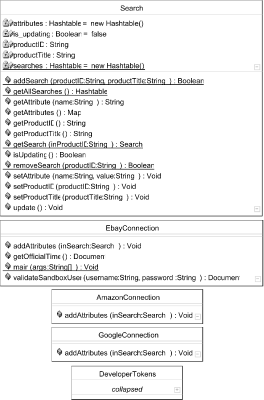 The four static methods, addSearch( ), getAllSearches( ), getSearch( ), and removeSearch( ), are the main points of interest to the JSP pages. All data about the web services results is contained in a set of simple name/value pairs, contained in the java.util.Hashtable variable attributes. When a search is run, the Search object is passed to the three supporting web service connection classes, and the appropriate data is set in attributes. The code shown in Example 4-6 shows the code for the Search class. Pay particular interest to the update( ) method. Example 4-6. Core Search classpackage com.cascadetg.ch04; import java.util.Hashtable; public class Search { // Static search Hashtable used for persistence. // This means that the data stored by this application is lost // every time the server is restarted. Adding support for // persistence is left as an exercise for the reader - the most // likely, of course, being saving the data to a database in some // fashion. // If you are interested in adding persistence, you'll want to // intercept the addSearch( ), removeSearch( ), and update( ) methods // in this class. private static Hashtable searches = new Hashtable( ); public static boolean addSearch( String productID, String productTitle) { if (productID == null) return false; if (productID.length( ) < 1) return false; if (productTitle == null) return false; if (productID.length( ) < 1) return false; if (searches.get(productID) != null) searches.remove(productID); Search mySearch = new Search( ); mySearch.setProductID(productID); mySearch.setProductTitle(productTitle); searches.put(productID, mySearch); mySearch.update( ); return true; } public static boolean removeSearch(String productID) { if (searches == null) { return true; } if (searches.get(productID) == null) return false; searches.remove(productID); return true; } public static Hashtable getAllSearches( ) { return searches; } public static Search getSearch(String inProductID) { return (Search)searches.get(inProductID); } // Simple object data. Note the use of a Hashtable to store // a variable set of attributes private String productID; private String productTitle; private Hashtable attributes = new Hashtable( ); public void setAttribute(String name, String value) { attributes.put(name, value); } public String getAttribute(String name) { return (String)attributes.get(name); } public java.util.Map getAttributes( ) { java.util.TreeMap map = new java.util.TreeMap(java.text.Collator.getInstance( )); map.putAll(attributes); return map; } /** Returns the product ID (specifically, a book ISBN). */ public String getProductID( ) { return productID; } /** Set the product ID (specificially, a book ISBN). */ public void setProductID(String productID) { this.productID = productID; } public String getProductTitle( ) { return productTitle; } public void setProductTitle(String productTitle) { this.productTitle = productTitle; } // Updating data logic // Note that this updating logic isn't as useful as it should be, // as the update( ) ought to kick off a new thread. private boolean is_updating = false; public boolean isUpdating( ) { return is_updating; } public void update( ) { // Don't allow the user to set up dozens of hits on the site at // once. Ideally, you should be more conservative about kicking // off requests, perhaps using an aggregation approach (as // described in Chapter 8, News Aggregator if (is_updating) return; is_updating = true; // Create a new Search and set the values to the existing // search Search mySearch = new Search( ); mySearch.setProductID(this.productID); mySearch.setProductTitle(this.productTitle); // Kick off the requests to the various web services new AmazonConnection( ).addAttributes(mySearch); new EbayConnection( ).addAttributes(mySearch); new GoogleConnection( ).addAttributes(mySearch); // Replace the old attributes with the newly discovered values this.attributes = mySearch.attributes; is_updating = false; } }It's easy to imagine enhancements: the underlying system might implement a Connection interface, with the potential to add new web services dynamically. One other thing you may have noticed: the getAttributes() method returns a java.util.Map, instead of the underlying Hashtable. As shown in Example 4-7, the code creates a TreeMap that keeps the attributes sorted by the system's default locale interpretation of an "alphabetical" sorting routine. Example 4-7. Sorting codejava.util.TreeMap map = new java.util.TreeMap(java.text.Collator.getInstance( )); map.putAll(attributes); Now, on to the real meat of the application the web services connectivity. 4.2.1 Connecting to AmazonThe Amazon web services package is implemented according to the commonly regarded interpretation of web services a series of SOAP methods, complete with a WSDL file describing their offerings. We will use Axis, as described in Chapter 3, to work with Amazon's web services. Before working with Amazon's web services, you must register with Amazon's developer program at http://www.amazon.com/webservices/, as shown in Chapter 4. Figure 4-8. Signing up for Amazon web services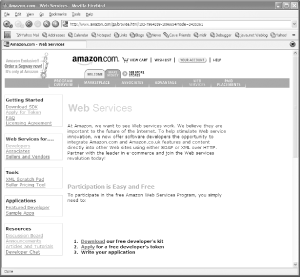 The instructions are straightforward: you must download the developer kit (a single file, kit.zip) and get a web services token. This token, a simple string, is used by Amazon to uniquely identify you when you are accessing web services. You should treat this token as you would any password. As shown in Figure 4-9, you'll find a number of examples for a variety of programming languages as well as the documentation. Figure 4-9. Contents of the Amazon SDK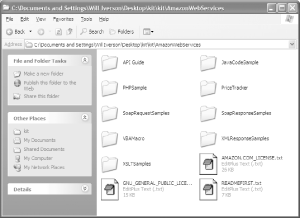 Open the file kit/API Guide/index.html in your web browser to see the documentation, as shown in Figure 4-10. Figure 4-10. Amazon SDK documentation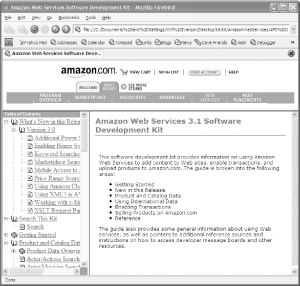 In our case, we'll use Axis to generate access code from the Amazon-supplied WSDL file. The Amazon WSDL file, as described in the READMEFIRST.txt file, can be found at http://soap.amazon.com/schemas3/AmazonWebServices.wsdl. This WSDL file is used by the Axis WSDL2Java tool to generate a set of Java bindings. The easiest way to do this is to open a command prompt and navigate to the Axis library installation directory. Then, execute the following command, all as one line, as shown in Example 4-8. Note that you need an Internet connection for this to work. Example 4-8. Generating Amazon Java bindings from WSDLC:\devenv\axis-1_1\lib>java -classpath commons-logging.jar; log4j-1.2.8.jar;wsdl4j.jar;axis.jar;commons-discovery.jar; jaxrpc.jar;saaj.jar org.apache.axis.wsdl.WSDL2Java http://soap.amazon.com/schemas3/AmazonWebServices.wsdl If successful, there will be no visible output on the command line, but you will now have a set of Java classes corresponding to the Amazon SDK in the Axis directory. As shown in Figure 4-11, these classes are neatly sorted into a com.amazon.soap package. Although you are given the source to these classes by this tool, you won't want to edit them manually. You will likely want to regenerate these files any time Amazon adds new functionality. Figure 4-11. Generated Amazon Java Axis source Copy these files out of this directory and into your Java source tree. The bulk of the generated classes essentially serve as data holders for Amazon web service operations. To access the web services, use the AmazonSearchServiceLocator class to retrieve a service and an AmazonSearchPort to handle web service requests. The AmazonSearchServiceLocator class hierarchy is shown in Figure 4-12. Figure 4-12. Amazon service locator class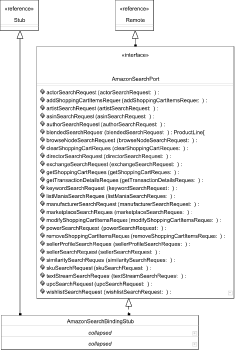 After retrieving a service, you use a search port object to perform requests. The generated class hierarchy is shown in Figure 4-13. Note that the methods of the AmazonSearchPort class take instances of other classes generated by the Axis toolkit as parameters. Figure 4-13. Amazon port request class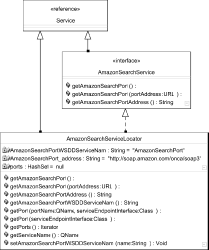 The code shown in Example 4-9 shows how to actually make a connection to the Amazon web services. In this case, an instance of the AsinRequest class is used. The call to myAmazonSearchPort.asinSearchRequest(myAsinRequest) actually performs the request. It transforms the underlying data to SOAP, sends the data over the network, retrieves the resulting data, and transforms that data back into Java object(s), in this case a ProductInfo object. Example 4-9. Connecting to Amazon web servicespackage com.cascadetg.ch04; import java.util.Date; import com.amazon.soap.*; public class AmazonConnection { public void addAttributes(Search inSearch) { inSearch.setAttribute( "Amazon Last Check", new Date( ).toLocaleString( )); // Mac OS X for Java Geeks ISBN //String isbn = "0596004001"; try { AmazonSearchService myAmazonSearchService = new AmazonSearchServiceLocator( ); AmazonSearchPort myAmazonSearchPort = myAmazonSearchService.getAmazonSearchPort( ); AsinRequest myAsinRequest = new AsinRequest( ); // Use this to set your Amazon Associates ID // For more info on Amazon Associates, see... // http://www.amazon.com/associates myAsinRequest.setTag(DeveloperTokens.amazon_associates); myAsinRequest.setDevtag(DeveloperTokens.amazon_token); myAsinRequest.setAsin(inSearch.getProductID( )); myAsinRequest.setLocale("us"); myAsinRequest.setType("heavy"); ProductInfo myProductInfo = myAmazonSearchPort.asinSearchRequest(myAsinRequest); Details[] myDetailsArray = myProductInfo.getDetails( ); Details myDetail = null; if (myDetailsArray != null) { myDetail = myDetailsArray[0]; inSearch.setAttribute( "Amazon Product Name", myDetail.getProductName( )); inSearch.setAttribute( "Amazon Release Date", myDetail.getReleaseDate( )); inSearch.setAttribute( "Amazon Actual Prize", myDetail.getOurPrice( )); inSearch.setAttribute( "Amazon List Price", myDetail.getListPrice( )); inSearch.setAttribute( "Amazon Used Price", myDetail.getUsedPrice( )); inSearch.setAttribute( "Amazon Sales Rank", myDetail.getSalesRank( )); inSearch.setAttribute( "Amazon Availability", myDetail.getAvailability( )); //myDetail.getImageUrlSmall( ); //myDetail.getImageUrlMedium( ); //myDetail.getImageUrlLarge( ); } } catch (Exception e) { e.printStackTrace( ); } } }The code shown in Example 4-9 is as close to a standard RPC system as a web service is likely to be. None of the actual connectivity details are in the code: all of the URLs, ports, and other connectivity information are in the WSDL and then embedded in the code generated by the WSDL2Java tool. 4.2.2 Connecting to eBayeBay's web service implementation provides access to their systems via XML over HTTPS. A simple HTTPS connection provides in-transit security, and XML data is sent and received to perform operations. While establishing an HTTPS connection to the eBay servers is a relatively trivial matter, working with the XML documents is more time-consuming.
As of mid-2004, there are several tiers of access offered by eBay, based more or less on the quantity of web service requests you require. The free, individual developer version allows for only 50 calls a day not very many, but likely enough to build and do some basic testing of your application. The next step up, called Basic, offers 30,000 calls per month for $500 per year. By default, you have access to the eBay sandbox server, a test environment set up for developers to test their application without incurring service fees. To access the production server, you must be certified by eBay (as of this writing, eBay charges $100 for certification). If you're looking at building a production application that accesses eBay services, you need to include these access and certification fees in your budget. Don't forget that it can take several days to get your application certified. The eBay sandbox, http://sandbox.ebay.com/, shown in Figure 4-14, is a good development resource. It's a recreation of the eBay web site (http://www.ebay.com/) and is intended for developers to test their application. There are several portions of the web site that aren't implemented or work slightly differently; for example, you can't actually enter a credit card and authenticate a user to sell items on the test server. Instead, you use eBay web services to do this programmatically using the web services API. Figure 4-14. eBay sandbox site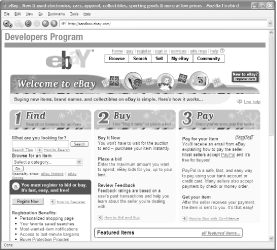 The eBay developer registration system is a bit more complex than other offerings in order to support more complex deployment and usage models. First, you need to register for eBay itself and then go through the six-step registration process (http://developer.ebay.com/
4.2.2.1 eBay API wrapperIn order to make it easier to connect to eBay in this chapter (and others), the sample applications use a standard eBay connectivity class, as shown in Figure 4-15, as a reusable component for connecting to eBay's XML-via-HTTPS web services. Figure 4-15. eBay web service utility class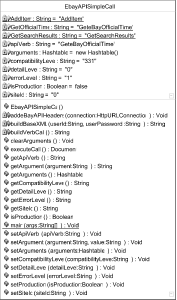 The code for the eBay class is shown in Example 4-10. All the details of opening a connection to eBay, sending the XML, and then retrieving the results are wrapped by this class. The code is designed to make a call as simple as possible: create a new EbayAPISimpleCall object, set the eBay "verb" you wish to call, and add the arguments you need with EbayAPISimpleCall.setArgument(). Example 4-10. eBay API simple callpackage com.cascadetg.ch04; import java.net.*; import java.io.*; import java.util.Hashtable; /** * Based on the eBay sample code, APISimpleCallJava.java */ public class EbayAPISimpleCall { // The eBay API function private String apiVerb = "GeteBayOfficialTime"; /** API Verb used to get the official eBay time */ public static final String GetOfficialTime = "GeteBayOfficialTime"; /** API Verb used to search on eBay */ public static final String GetSearchResults = "GetSearchResults"; // The version threshold of compatibility for the eBay API call private String compatibilityLevel = "331"; // The error level for the API call private String errorLevel = "1"; // Set siteId to correspond to the US Site private String siteId = "0"; // "0" is the only supported detail level for GetebayOfficialTime private String detailLevel = "0"; public EbayAPISimpleCall( ) { } boolean isProduction = false; public org.jdom.Document executeCall( ) { // Supply a URL to the desired API server, for example: // Sandbox: https://api.sandbox.ebay.com/ws/api.dll // Production: https://api.ebay.com/ws/api.dll String targetURL; if (!isProduction) { targetURL = "https://api.sandbox.ebay.com/ws/api.dll"; } else { targetURL = "https://api.ebay.com/ws/api.dll"; } // This string will contain the assembled XML for the API call String eBayXML; try { // Create a new URL object using the specified targetURL URL website = new URL(targetURL); // Create a connection to the URL Object foo = website.openConnection( ); // Note that this is actually an SSL connection, even // though cast to an HttpURLConnection. Different JDK // versions use a different SSL connection class, but they // all use HttpURLConnection as the base class (which has // the methods we need). HttpURLConnection connection = (HttpURLConnection)website.openConnection( ); // Specify that the connection will be used for input and // output connection.setDoInput(true); connection.setDoOutput(true); // Specify the method for the URL request connection.setRequestMethod("POST"); // Add the eBay specific headers needed for an eBay API // call // see: "Making the HTTP request" in the eBay API // documentation addeBayAPIHeaders(connection); // Build the XML call String for eBayGetOfficialTime eBayXML = buildBaseXML( DeveloperTokens.eBay_userid, DeveloperTokens.ebay_userPassword) + buildVerbCall( ); // Create the Output and Print Streams OutputStream output = connection.getOutputStream( ); PrintStream pout = new PrintStream(output); // 'Upload' the eBayXML String pout.print(eBayXML); pout.close( ); // Create the Input Streams InputStream input = connection.getInputStream( ); BufferedInputStream bufIn = new BufferedInputStream(input); org.jdom.Document result = new org.jdom.input.SAXBuilder( ).build(bufIn); connection.disconnect( ); return result; } catch (MalformedURLException ex) { ex.printStackTrace( ); } catch (IOException ioException) { ioException.printStackTrace( ); } catch (org.jdom.JDOMException JDOMprob) { JDOMprob.printStackTrace( ); } return null; } // A test routine to verify that everything is working. public static void main(String[] args) throws IOException { EbayAPISimpleCall myCall = new EbayAPISimpleCall( ); myCall.setApiVerb(GetOfficialTime); org.jdom.Document myDocument = myCall.executeCall( ); new org.jdom.output.XMLOutputter( ).output( myDocument, System.out); myCall.setApiVerb(GetSearchResults); myCall.setArgument("Query", "test"); myDocument = myCall.executeCall( ); new org.jdom.output.XMLOutputter( ).output( myDocument, System.out); String result = myDocument.getRootElement( ).getChild("eBayTime").getText( ); System.out.println(result); result = myDocument .getRootElement( ) .getChild("Search") .getChild("GrandTotal") .getText( ); System.out.println(result); } private void addeBayAPIHeaders(HttpURLConnection connection) { // Generate and add the Session Certificate Header connection.addRequestProperty( "X-EBAY-API-SESSION-CERTIFICATE", DeveloperTokens.ebay_devId + ";" + DeveloperTokens.appId + ";" + DeveloperTokens.certId); // Add the Compatibility Level Header connection.addRequestProperty( "X-EBAY-API-COMPATIBILITY-LEVEL", compatibilityLevel); // Add the Developer Name, Application Name, and Certification // Name headers connection.addRequestProperty( "X-EBAY-API-DEV-NAME", DeveloperTokens.ebay_devId); connection.addRequestProperty( "X-EBAY-API-APP-NAME", DeveloperTokens.appId); connection.addRequestProperty( "X-EBAY-API-CERT-NAME", DeveloperTokens.certId); // Add the API verb Header connection.addRequestProperty("X-EBAY-API-CALL-NAME", apiVerb); // Add the Site Id Header connection.addRequestProperty("X-EBAY-API-SITEID", siteId); // Add the Detail Level Header connection.addRequestProperty( "X-EBAY-API-DETAIL-LEVEL", detailLevel); // Add the Content-Type Header connection.addRequestProperty("Content-Type", "text/xml"); // NOTE: eBay recommends setting the Content-Length header // see: "Making the HTTP request" in the eBay API documentation } private String buildBaseXML(String userId, String userPassword) { return "<?xml version='1.0' encoding='utf-8'?>\r\n" + "<request>\r\n" + "<RequestUserId>" + userId + "</RequestUserId>\r\n" + "<RequestPassword>" + userPassword + "</RequestPassword>\r\n"; } Hashtable arguments = new Hashtable( ); public void clearArguments( ) { arguments = new Hashtable( ); } public Hashtable getArguments( ) { return arguments; } public void setArgument(String argument, String value) { arguments.put(argument, value); } public String getArgument(String argument) { return (String)arguments.get(argument); } public void setArguments(Hashtable arguments) { this.arguments = arguments; } private String buildVerbCall( ) { StringBuffer verbCall = new StringBuffer( ); verbCall.append("<ErrorLevel>"); verbCall.append(errorLevel); verbCall.append("</ErrorLevel>\r\n"); verbCall.append("<Verb>"); verbCall.append(apiVerb); verbCall.append("</Verb>\r\n"); verbCall.append("<DetailLevel>"); verbCall.append(detailLevel); verbCall.append("</DetailLevel>\r\n"); verbCall.append("<SiteId>"); verbCall.append(siteId); verbCall.append("</SiteId>\r\n"); if (arguments.size( ) > 0) { java.util.Enumeration keys = arguments.keys( ); while (keys.hasMoreElements( )) { String current = (String)keys.nextElement( ); verbCall.append("<"); verbCall.append(current); verbCall.append(">"); verbCall.append(arguments.get(current)); verbCall.append("</"); verbCall.append(current); verbCall.append(">"); } } verbCall.append("</request>"); return verbCall.toString( ); } /** * @return Returns the detailLevel. */ public String getDetailLevel( ) { return detailLevel; } /** * @param detailLevel * The detailLevel to set. */ public void setDetailLevel(String detailLevel) { this.detailLevel = detailLevel; } /** * @return Returns the errorLevel. */ public String getErrorLevel( ) { return errorLevel; } /** * @param errorLevel * The errorLevel to set. */ public void setErrorLevel(String errorLevel) { this.errorLevel = errorLevel; } /** * @return Returns the siteId. */ public String getSiteId( ) { return siteId; } /** * @param siteId * The siteId to set. */ public void setSiteId(String siteId) { this.siteId = siteId; } /** * @return Returns the compatibilityLevel. */ public String getCompatibilityLevel( ) { return compatibilityLevel; } /** * @param compatibilityLevel * The compatibilityLevel to set. This controls the * versioning of the XML interface for the API. This is * how eBay allows multiple versions of their API to be * supported simultaneously. */ public void setCompatibilityLevel(String compatibilityLevel) { this.compatibilityLevel = compatibilityLevel; } /** * @return Returns the isProduction. */ public boolean isProduction( ) { return isProduction; } /** * @param isProduction * By default (isProduction = false), the server will * contact the eBay test environment, called the * "sandbox." If you wish to use the production * environment, you'll need to set this to true. */ public void setProduction(boolean isProduction) { this.isProduction = isProduction; } public String getApiVerb( ) { return apiVerb; } /** * Two standard verbs are provided with this class, * GeteBayOfficialTime and GetSearchResults. Others can be added * from the eBay documentation. */ public void setApiVerb(String apiVerb) { this.apiVerb = apiVerb; } }For eBay, a verb is the term that describes the name of a web service method. Each verb describes a particular action, with a set of one or more possible parameters. These verbs generally have self-describing names, such as GeteBayOfficialTime or GetSearchResults. eBay's documentation lists many verbs; using our EbayAPISimpleCall. setApiVerb() method, it's easy to call any of them. Two static String objects are defined in this class; they correspond to the official eBay verbs. An enterprising developer might imagine developing a custom class hierarchy corresponding to the eBay framework. However, keep in mind that this class hierarchy quickly looks like the bindings generated by a SOAP framework! When you're ready, call EbayAPISimpleCall.executeCall( ), and you'll receive a result via a JDOM object (which holds the XML returned by eBay). If the result is an eBay error message, that is the contents of the XML; otherwise, it should be the data you need. The code to make the call into eBay is only support infrastructure; it doesn't actually help you write your application. It's analogous to the code generated by the WSDL2Java code in the previous example (talking to Amazon), but in this case, you have to maintain it yourself.
4.2.2.2 eBay connectivityNow that you have a reusable wrapper for accessing eBay web services, it's time to look at the code to actually get useful data back from the eBay service. As mentioned earlier, you must create and validate a user on the sandbox in order to perform certain activities, such as searches. The main( ) method of the code shown in Example 4-11 can be used to authenticate a user as a command-line utility if needed. The addAttributes() method is called by the Search object to retrieve data from eBay a straightforward operation, given the wrapper shown in Example 4-10. Example 4-11. Retrieving data from eBaypackage com.cascadetg.ch04; import java.util.Date; import org.jdom.output.XMLOutputter; public class EbayConnection { public org.jdom.Document validateSandboxUser( String username, String password) { EbayAPISimpleCall myCall = new EbayAPISimpleCall( ); // Validate this user on the sandbox server only myCall.setProduction(false); myCall.setApiVerb("ValidateTestUserRegistration"); myCall.setArgument("RequestUserId", username); myCall.setArgument("RequestPassword", password); return myCall.executeCall( ); } /** * Call this class, passing in the username and password you would * like to register on the eBay test server. * * @param args */ static public void main(String[] args) { if (args == null) { System.out.println("Need two arguments (name & password)."); return; } if (args.length < 2) { System.out.println("Need two arguments (name & password)."); return; } try { new XMLOutputter( ).output( new EbayConnection( ).validateSandboxUser( args[0], args[1]), System.out); } catch (Exception e) { System.out.println("Unable to register user."); e.printStackTrace( ); } } public void addAttributes(Search inSearch) { inSearch.setAttribute( "eBay Last Check", new Date( ).toLocaleString( )); EbayAPISimpleCall myCall = new EbayAPISimpleCall( ); myCall.setApiVerb(EbayAPISimpleCall.GetSearchResults); myCall.setArgument("Query", inSearch.getProductTitle( )); myCall.setArgument("Order", "MetaHighestPriceSort"); org.jdom.Document myResults = myCall.executeCall( ); org.jdom.Element root = myResults.getRootElement( ); long count = Long.parseLong( root .getChild("Search") .getChild("GrandTotal") .getText( )); inSearch.setAttribute( "eBay Total Matching Listings", Long.toString(count)); if (count > 0) { org.jdom.Element item = root.getChild("Search").getChild("Items").getChild( "Item"); inSearch.setAttribute( "eBay Highest Bid Item Price", item.getChildText("LocalizedCurrentPrice")); inSearch.setAttribute( "eBay Highest Bid Item Bids", item.getChildText("BidCount")); inSearch.setAttribute( "eBay Highest Bid Item Link", item.getChildText("Link")); } } }
Lets take a closer look at the connectivity code, as shown in Example 4-12. It starts by creating a object to represent the call to eBay, EbayAPISimpleCall. It then sets the eBay verb to use. In the sample, a search is being performed, but you can find documentation on other supported verbs at http://developer.ebay.com/DevZone/docs/API_Doc/index.asp. Next, the arguments are set. For a search query, the search terms must be specified in this case, the title of the book. The application also needs the highest value auction result, so a second argument, Order, is added with the string MetaHighestPriceSort (as specified by the eBay documentation for the search verb). The call is then issued, and an XML document containing the results of the query is returned. From there, it's just a question of using the JDOM interfaces to walk through the returned XML. Example 4-12. eBay connection code. EbayAPISimpleCall myCall = new EbayAPISimpleCall( ); myCall.setApiVerb(EbayAPISimpleCall.GetSearchResults); myCall.setArgument("Query", inSearch.getProductTitle( )); myCall.setArgument("Order", "MetaHighestPriceSort"); org.jdom.Document myResults = myCall.executeCall( );To more fully support this, you may wish to perform more robust error handling (indeed, you'll be required to do this to pass eBay's certification), but it shows how even with a nonstandard API, a bit of work can decouple the details of establishing the network connection from the rest of your application logic. 4.2.3 Connecting to GoogleAfter the previous examples, it may surprise you to see how easy it is to connect to Google's web service offerings. Visiting http://www.google.com/apis/, shown in Figure 4-16, it's pretty straightforward to start building applications using the Google web service interface. Make sure you download the developer kit as shown on the front page; you will need the provided libraries. Figure 4-16. Google API home page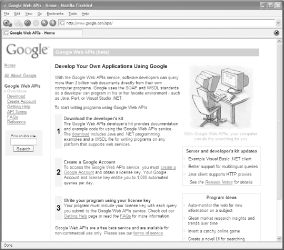 Google does offer APIs via SOAP and WSDL, but for Java developers, there's a pre-built library that does all the work for you. It's as if they took the time to run Axis WSDL2Java for you, and then just provided you with a library to use (in fact, that's very close to what they actually did). It's entirely possible to use Axis to generate the Java code from their WSDL file (posted at http://api.google.com/GoogleSearch.wsdl) just as you did for Amazon. Instead, you should rely on the Java library they provided, called googleapi.jar, as shown in Figure 4-17. You must add this library to your class path. For more information on the Google API, open the APIs_Reference.html file. Figure 4-17. Contents of the Google SDK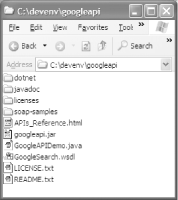 The code as shown in Example 4-13 could hardly be simpler. More lines are spent looping through the results and adding them to the Search object's attributes than it takes to get data back from the Google server itself. The code converts the GoogleSearchResult objects to Strings and add them to the results given, but it's easy to imagine using the various methods on the GoogleSearchResult object to get more detail and provide even better formatting. Example 4-13. Google connectivitypackage com.cascadetg.ch04; import java.util.Date; import com.google.soap.search.*; public class GoogleConnection { public void addAttributes(Search inSearch) { inSearch.setAttribute( "Google Last Check", new Date( ).toLocaleString( )); GoogleSearch search = new GoogleSearch( ); // Set mandatory attributes search.setKey(DeveloperTokens.googleKey); search.setQueryString(inSearch.getProductTitle( )); // Set optional attributes search.setSafeSearch(true); // Invoke the actual search GoogleSearchResult result = null; try { result = search.doSearch( ); } catch (GoogleSearchFault e) { e.printStackTrace( ); } // process the result if (result != null) { inSearch.setAttribute( "Google Number of Hits", Integer.toString( result.getEstimatedTotalResultsCount( ))); GoogleSearchResultElement[] mySearchElements = result.getResultElements( ); for (int i = 0; i < mySearchElements.length; i++) { inSearch.setAttribute( "Google Result " + i, mySearchElements[i].toString( )); if (i > 4) { i = mySearchElements.length; } } } } }4.2.4 Developer TokensYou may have noticed references to a DeveloperTokens class (e.g. DeveloperTokens.amazon_associates, or DeveloperTokens.amazon_token). This class is a single static class with a set of Strings containing the various developer tokens used throughout this chapter. The class shown in Example 4-14 contains only placeholder strings of the approximate correct length. Example 4-14. Private developer tokenspackage com.cascadetg.ch04; public class DeveloperTokens { // Amazon userID token public static String amazon_token = "12345678901234"; // Amazon assoicates ID public static String amazon_associates = "123456789-20"; // eBay userID (the "visible" user identification, i.e. the buyer & // seller user. public static String eBay_userid = "1234567890"; public static String ebay_userPassword = "1234567890"; // devId, appId, certId as specified by the eBay Developer's // Program public static String ebay_devId = "123456789012345678901234567890"; public static String appId = "123456789012345678901234567890"; public static String certId = "123456789012345678901234567890"; // Google web services ID key public static String googleKey = "12345678901234567890123456789012"; }As you've seen, actually making the connection to a provider isn't that hard (especially after creating bindings or utility classes to make it easier to access). Different vendors have different registration systems, pricing models, and different expectations in terms of security, but at least all offer free access to their system for developers to start building and testing applications, and all have published documentation and interfaces. |
| < Day Day Up > |
- Article 210 Branch Circuits
- Article 340 Underground Feeder and Branch-Circuit Cable Type UF
- Tables 12(A) and 12(B)
- Example No. D2(c) Optional Calculation for One-Family Dwelling with Heat Pump(Single-Phase, 240/120-Volt Service) (See 220.82)
- Example No. D10 Feeder Ampacity Determination for Adjustable-Speed Drive Control [See 215.2, 430.24, 620.13, 620.14, 620.61, Tables 430.22(E), and 620.14]
 Membership
Membership